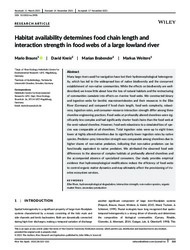Habitat availability determines food chain length and interaction strength in food webs of a large lowland river
DOI: https://doi.org/10.1002/rra.3908
Persistent URL: http://resolver.sub.uni-goettingen.de/purl?gldocs-11858/9835
Persistent URL: http://resolver.sub.uni-goettingen.de/purl?gldocs-11858/9835
Brauns, Mario; Kneis, David; Brabender, Marian; Weitere, Markus, 2021: Habitat availability determines food chain length and interaction strength in food webs of a large lowland river. In: River Research and Applications, Band 38, 2: 323 - 333, DOI: 10.1002/rra.3908.
 |
Dokument öffnen: |
Many large rivers used for navigation have lost their hydromorphological heterogeneity, which has led to the widespread loss of native biodiversity and the concurrent establishment of non‐native communities. While the effects on biodiversity are well‐described, we know little about how the loss of natural habitats and the restructuring of communities cumulate into effects on riverine food webs. We constructed binary and ingestion webs for benthic macroinvertebrates and their resources in the Elbe River (Germany) and compared if food chain length, food web complexity, robustness, ingestion rates, and consumer‐resource interaction strength differ among three shoreline engineering practices. Food webs at profoundly altered shorelines were significantly less complex and had significantly shorter food chains than the food web at the semi‐natural shoreline. However, food web robustness to a simulated loss of species was comparable at all shorelines. Total ingestion rates were up to eight times lower at highly altered shorelines due to significantly lower ingestion rates by native species. Predator–prey interaction strength was comparable among shorelines due to higher shares of non‐native predators, indicating that non‐native predators can be functionally equivalent to native predators. We attributed the observed food web differences to the absence of complex habitats at profoundly altered shorelines and the accompanied absence of specialized consumers. Our study provides empirical evidence that hydromorphological modifications reduce the efficiency of food webs to control organic matter dynamics and may ultimately affect the provisioning of riverine ecosystem services.
Statistik:
ZugriffsstatistikSammlung:
Schlagworte:
Elbe Riverhydromorphological degradation
interaction strength
non‐native species
organic matter flows
secondary production
This is an open access article under the terms of the Creative Commons Attribution License, which permits use, distribution and reproduction in any medium, provided the original work is properly cited.

